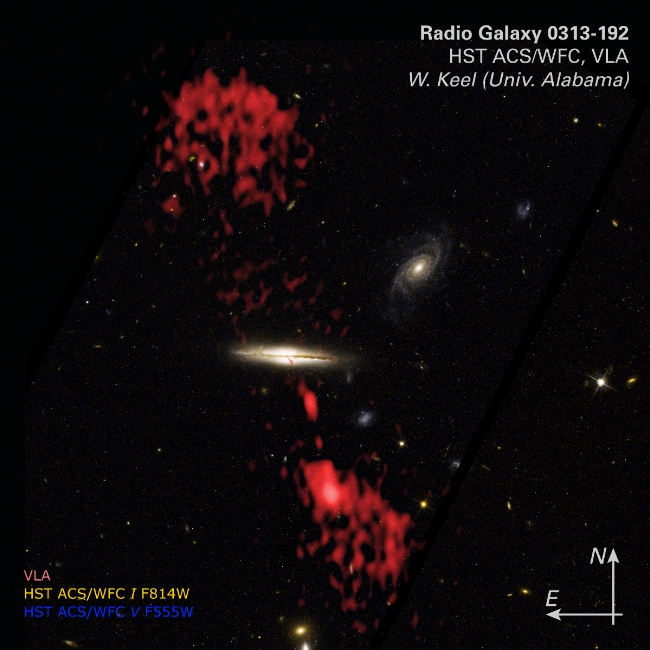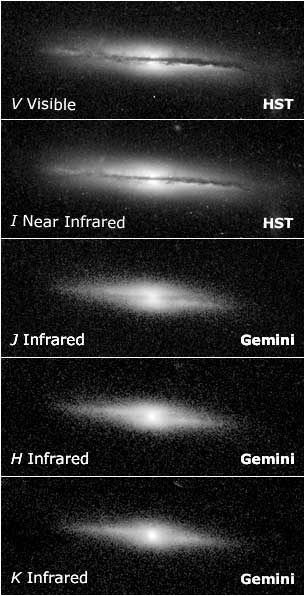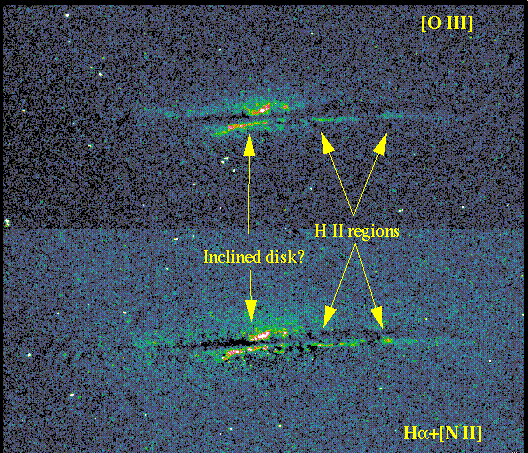
This is additional information to accompany the HST/VLA/Gemini press release. Much is from the display presentation by Keel, Ledlow, and Owen at the January 2003 meeting of the American Astronomical Society in Seattle.

Powerful double radio sources universally arise from elliptical galaxies or merger remnants, which has shaped theories of their origin. Thus, it was important to confirm the nature of the disk galaxy identified with the 200-kpc FR I source 0313-192 at z=0.067. HST ACS and Gemini-S JHK images show clearly that this is indeed a spiral galaxy, seen within 0.5° of edge-on. The dust lane is thick, highly structured, and warped by 3° to the starlight midplane. The stellar disk is thick and red, with z scale height nearly 1/4 of the radial scale length. H II regions are visible in the disk plane where the warp or gaps allow us to see them around the dust. Star formation, radial extent of the dust, and modest bulge/disk ratio all indicate that the galaxy is a genuine spiral, the only one identified to host a giant double radio source. Ha and [O III] emission trace a nuclear structure spanning ~5 kpc, tilted by ~30° to the disk and perpendicular to the inner radio jet, which is more like an inner disk than ionization cones. The optical depth from dust (as well as H I) is comparable to that in our own disk. Reddened nuclear light becomes prominent at K, at a location matching both the radio core and the center of the bulge isophotes. Several of these features may be remnants of a minor merger in this unusually luminous spiral, which might give clues to how such an unusual host can support a large and powerful double radio source. A luminous bulge, dynamical perturbation, group environment, and jet axis nearly perpendicular to the disk might all be implicated in allowing the "wrong" kind of host galaxy to show this powerful activity.
This work was supported by NASA under STScI grant GO-09376.01A.
We present results from:
Registration using USNO A-2 stars shows that the infrared peak, radio core, and center of bulge isophotes coincide to at least 0.1".

|
Classifying the host galaxy of 0313-192 is interesting, since we view it within 0.5° of edge-on. We use criteria not involving the arm structure to conclude that this must be a genuine spiral (rather than S0). |
 |
Put together, these argue strongly that 0313-192 is a spiral galaxy, of type Sa or Sb. A funny place to find a large double radio source.
 ACS linear-ramp filter data
show normal disk H II
regions around the dust, plus
a structure inclined by about
30 to the stellar disk. This
is nearly perpendicular to the
radio jet axis. This may be
gas in an inner disk, perhaps
recently accreted and not
yet settled into the disk.
This is large compared to
dusty disks in many radio
galaxies, but the orientation
is suspicious.The
[O III]/Ha
ratio is nearly constant
throughout this structure,
which suggests (along with
the orientation) that it is not
an ionization cone. The dust
lane makes it clear why the
optical spectrum lacks
signs of a broad-line region.
ACS linear-ramp filter data
show normal disk H II
regions around the dust, plus
a structure inclined by about
30 to the stellar disk. This
is nearly perpendicular to the
radio jet axis. This may be
gas in an inner disk, perhaps
recently accreted and not
yet settled into the disk.
This is large compared to
dusty disks in many radio
galaxies, but the orientation
is suspicious.The
[O III]/Ha
ratio is nearly constant
throughout this structure,
which suggests (along with
the orientation) that it is not
an ionization cone. The dust
lane makes it clear why the
optical spectrum lacks
signs of a broad-line region.
What makes 0313-192 the only spiral galaxy we know of within a billion light years to host a giant double radio source? We do have a few speculations.
For something this rare, a combination of these factors may have to conspire.
Some relevant links:
Last changes: 12/2002 © 2002